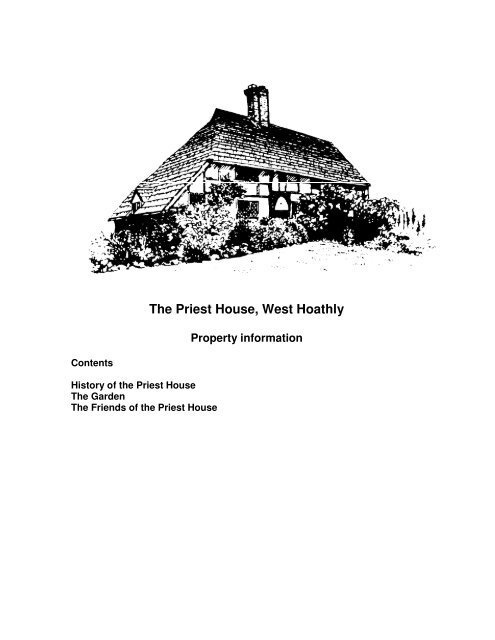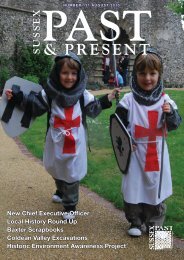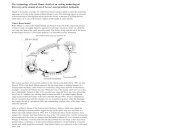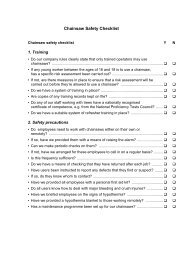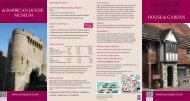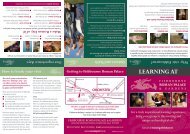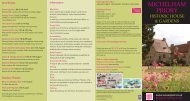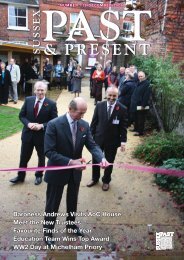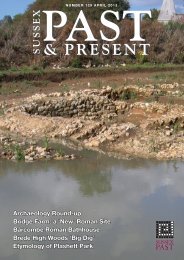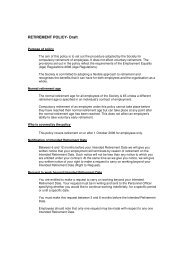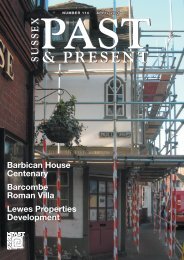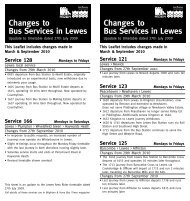The Priest House, West Hoathly - The Sussex Archaeological Society
The Priest House, West Hoathly - The Sussex Archaeological Society
The Priest House, West Hoathly - The Sussex Archaeological Society
Create successful ePaper yourself
Turn your PDF publications into a flip-book with our unique Google optimized e-Paper software.
<strong>The</strong> <strong>Priest</strong> <strong>House</strong>, <strong>West</strong> <strong>Hoathly</strong><br />
Property information<br />
Contents<br />
History of the <strong>Priest</strong> <strong>House</strong><br />
<strong>The</strong> Garden<br />
<strong>The</strong> Friends of the <strong>Priest</strong> <strong>House</strong>
History of the <strong>Priest</strong> <strong>House</strong>, <strong>West</strong> <strong>Hoathly</strong><br />
In the year 1392 Pope Urban VI gave the Cluniac Priory of St. Pancras in Lewes<br />
permission to appropriate land in the parish of <strong>West</strong> <strong>Hoathly</strong>. <strong>The</strong> Manor of the<br />
Rectory of <strong>West</strong> <strong>Hoathly</strong> was created from land that had previously formed part of<br />
the Manor of Lindfield.<br />
However, the Manor lands were neglected & in 1426 the<br />
Parishioners petitioned Pope Martin V about the Priory’s management.<br />
It was possibly as a response to this that <strong>The</strong> <strong>Priest</strong> <strong>House</strong> was built, as an estate<br />
office, in the late 1420’s. In 1524 the Priory leased the Rectory Manor to John<br />
Browne & <strong>The</strong> <strong>Priest</strong> <strong>House</strong> became a family home.<br />
Henry VIII seized the property of Lewes Priory in 1538 & the Browne’s Manor was<br />
given to Thomas Cromwell. When he was disgraced & beheaded in 1540 the<br />
Manor formed part of the divorce settlement of Anne of Cleves. John Browne,<br />
however, continued as tenant until his death. His son, Thomas, succeeded him.<br />
After the death of Anne of Cleves he paid rent to Queen Mary for a year & then to<br />
Elizabeth I. In 1560 the Queen sold the property that had once belonged to<br />
Lewes Priory & Thomas Browne bought the Manor lands & <strong>The</strong> <strong>Priest</strong> <strong>House</strong>.<br />
<strong>The</strong> house remained in the hands of the Browne family until 1695 when the<br />
Manor was sold to pay off their debts.<br />
<strong>The</strong> new owner was Mrs. Anna Hooper of Barbados. She divided the house into<br />
two cottages but took little interest in her property. In 1731 the land was sold to<br />
Robert Bostock of Otford, Kent. <strong>The</strong> Bostock family held the land for 150 years<br />
but did little to maintain <strong>The</strong> <strong>Priest</strong> <strong>House</strong> & in 1879 they sold the land to John<br />
Cotton Powell.<br />
By the beginning of the 20th Century the house was almost a ruin but in 1905 it<br />
was bought by John Godwin King, of Stonelands, <strong>West</strong> <strong>Hoathly</strong>. He had the<br />
house restored & in 1908 he opened it to the public.<br />
In 1935 John Godwin King presented <strong>The</strong> <strong>Priest</strong> <strong>House</strong> & its contents to the<br />
<strong>Sussex</strong> <strong>Archaeological</strong> <strong>Society</strong>.<br />
<strong>The</strong> Garden<br />
<strong>The</strong> <strong>Priest</strong> <strong>House</strong> garden was planted when the house opened to the public in<br />
1908 and it retains many of its original features. <strong>The</strong> formal box hedges,<br />
herbaceous borders and espalier apple trees that form an avenue up to the front<br />
door are all original and the long yew hedge with its topiary figures was planted<br />
just a few years later.<br />
However, no garden ever stands still and the grounds have been substantially<br />
remodeled in recent years. <strong>The</strong> mixed borders of herbaceous perennials, herbs<br />
and shrubs were enlarged and replanted in 1989. By regularly adding new plants<br />
and allowing them the freedom to spread and seed themselves at will a colourful<br />
and exuberant planting scheme has been produced, typical of an old cottage<br />
garden.
In 1992 a more formal herb garden was added at the southern end of the house,<br />
bringing the number of herbs in the garden to well over 150 (including the daisies,<br />
dandelions and nettles!). Since 1997 a shrubbery and woodland area have also<br />
been added in the small secluded back garden.<br />
<strong>The</strong> Friends of the <strong>Priest</strong> <strong>House</strong><br />
<strong>The</strong> <strong>Priest</strong> <strong>House</strong> relies heavily on the active support of the Friends association.<br />
<strong>The</strong> Friends were formed in 1970 with the object of educating the public “by<br />
promotion, support, assistance & improvement of the <strong>Priest</strong> <strong>House</strong> Museum” &<br />
with the following powers:<br />
To further the charitable status of <strong>The</strong> <strong>Priest</strong> <strong>House</strong> & to encourage & help with<br />
the development of its facilities;<br />
To encourage & maintain the interest of the public in <strong>The</strong> <strong>Priest</strong> <strong>House</strong> as a<br />
building, a garden & a museum;<br />
To co-operate with the <strong>Sussex</strong> <strong>Archaeological</strong> <strong>Society</strong> & other bodies with similar<br />
objectives;<br />
To raise & provide funds to enable the Friends to carry out the objectives of the<br />
Friends in consultation with the S.A.S. & from time to time to make available<br />
resources for the well being of <strong>The</strong> <strong>Priest</strong> <strong>House</strong>.<br />
Currently the Friends:<br />
• Provide funds for maintenance, displays & exhibitions in the house.<br />
• Provide funds for the maintenance & improvement of the garden.<br />
• Produce goods for sale in the shop.<br />
• Organise social events for their members & the public.<br />
• Publish a newsletter for members.<br />
• act as Stewards in the custodian’s absence.<br />
<strong>The</strong> Corporate Plan of the <strong>Sussex</strong> <strong>Archaeological</strong> <strong>Society</strong> acknowledges the role<br />
played by the Friends associations. <strong>The</strong> Friends are vital to the running of <strong>The</strong><br />
<strong>Priest</strong> <strong>House</strong> & in the last 12 years they have contributed over £15,000 to the<br />
property.


